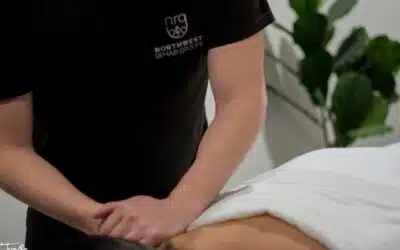I. Introduction
A. Brief overview of chiropractic care
Chiropractic is a healthcare profession that focuses on the diagnosis, treatment, and prevention of disorders affecting the musculoskeletal and nervous systems. Chiropractors employ a variety of non-invasive techniques to address issues related to spinal health, joint function, and overall well-being. As a patient-centred approach to healthcare, chiropractic care aims to improve the body’s natural ability to heal itself, promoting optimal function and long-term wellness.
B. Importance of addressing neck pain and improving range of motion
Neck pain is a common ailment affecting millions of people worldwide. It can significantly impact daily activities, work productivity, and overall quality of life. The neck, also known as the cervical spine, is a complex structure that is responsible for supporting the head and allowing for a wide range of motion. However, this flexibility can also make the neck more susceptible to injury and discomfort. Addressing neck pain and working to improve range of motion is essential for maintaining mobility, preventing further injury, and enhancing overall well-being.
C. The aim of the article: exploring chiropractic care for neck pain relief and better range of motion
This article aims to provide an in-depth look at how chiropractic care can help alleviate neck pain and improve range of motion. By exploring the anatomy of the neck, chiropractic techniques for pain relief, and methods for increasing flexibility, we aim to provide a comprehensive resource for individuals seeking a natural, non-invasive solution to their neck pain and restricted movement.
II. The Anatomy of the Neck
A. The cervical spine and its role in neck pain
The cervical spine consists of seven vertebrae that make up the uppermost part of the spinal column. These vertebrae, along with the muscles, ligaments, and nerves that surround them, work together to provide support, stability, and flexibility to the head and neck. The cervical spine plays a crucial role in the overall function of the neck, and any disruption or dysfunction in this area can lead to neck pain and discomfort.
B. Common causes of neck pain
Poor posture
Poor posture is a leading cause of neck pain. Slouching, hunching over a computer or phone, and maintaining improper ergonomics while working can strain the muscles and ligaments in the neck, leading to discomfort and stiffness. Over time, this can cause the cervical spine to shift out of alignment, exacerbating pain and limiting the range of motion.
Muscular imbalances
Muscular imbalances occur when certain muscles become overly tight or weak, causing undue stress on the cervical spine and surrounding structures. This can result from a sedentary lifestyle, repetitive motions, or inadequate physical activity. These imbalances can lead to muscle strain, inflammation, and even spinal misalignments, all of which contribute to neck pain.
Nerve compression
Nerve compression, also known as a pinched nerve, occurs when pressure is applied to a nerve by surrounding tissues, such as bones, cartilage, muscles, or tendons. In the cervical spine, nerve compression can result from spinal misalignments, herniated discs, or degenerative changes. This compression can cause pain, tingling, numbness, or weakness that may radiate from the neck down to the shoulders, arms, or hands.
Injury or trauma
Injuries or trauma to the neck, such as whiplash sustained in a car accident, sports injuries, or falls, can cause damage to the vertebrae, muscles, ligaments, and nerves in the cervical spine. This damage can lead to acute or chronic neck pain and restricted range of motion, depending on the severity and extent of the injury.

III. Chiropractic Care for Neck Pain Relief
A. Identifying the root cause of neck pain
Chiropractors begin the process of neck pain relief by conducting a thorough evaluation, including a detailed medical history and physical examination. This comprehensive assessment allows them to identify the root cause of neck pain, whether it be due to spinal misalignments, muscle imbalances, nerve compression, or injury. By understanding the underlying cause, chiropractors can develop targeted treatment plans that address the specific issues contributing to the patient’s discomfort.
B. Personalized care plans to address individual needs
Every patient is unique, and chiropractors recognize the importance of creating personalized care plans catering to each individual’s needs and circumstances. These plans may include a combination of non-invasive techniques, therapeutic exercises, and lifestyle recommendations to relieve neck pain and improve overall health and well-being.
C. Non-invasive techniques to relieve neck pain
Soft tissue mobilization
Soft tissue mobilization, also known as myofascial release, is a technique used by chiropractors to address muscle and fascial restrictions contributing to neck pain. By applying gentle, sustained pressure to tight and restricted areas, soft tissue mobilization helps to break up adhesions, improve blood flow, and restore flexibility to the affected muscles.
Trigger point therapy
Trigger points are localized areas of muscle tightness or knots that can refer pain to other parts of the body. Chiropractors use trigger point therapy to target these areas, applying direct pressure or using specific massage techniques to release the tension and alleviate pain. By addressing these trigger points, chiropractors can help to reduce neck pain and restore normal muscle function.
Instrument-assisted techniques
Instrument-assisted techniques involve the use of specialized tools to help chiropractors apply targeted pressure and mobilization to muscles, ligaments, and joints in the cervical spine. These tools can assist in breaking up scar tissue, reducing inflammation, and promoting optimal function and alignment of the cervical spine.
D. Success rates and patient satisfaction
Chiropractic care has been shown to be an effective and safe method for alleviating neck pain and improving range of motion. Numerous studies have demonstrated the benefits of chiropractic care for neck pain relief, with many patients experiencing significant improvements in their symptoms and overall quality of life. In addition, chiropractic care often receives high patient satisfaction ratings, as it offers a non-invasive, drug-free alternative for those seeking relief from their neck pain.
IV. Improving Range of Motion through Chiropractic Care
A. The relationship between neck pain and restricted range of motion
Neck pain and restricted range of motion often go hand in hand. When the cervical spine is misaligned, or the surrounding muscles are tight and imbalanced, it can limit the neck’s ability to move freely and comfortably.
This restricted movement can further exacerbate neck pain and contribute to additional strain on the spine and supporting structures. Therefore, improving the range of motion is an important aspect of addressing neck pain and promoting overall spinal health.
B. Techniques for increasing flexibility and movement
Muscle release techniques
Muscle release techniques, such as myofascial release and trigger point therapy, help to alleviate tension and tightness in the neck muscles, promoting increased flexibility and range of motion. By targeting specific areas of restriction, chiropractors can help to improve the overall function and mobility of the cervical spine.
Joint mobilization
Joint mobilization is a technique used by chiropractors to gently and safely improve the movement of joints in the cervical spine. Through the application of controlled force and movement, joint mobilization can help to increase flexibility, reduce pain, and restore proper joint function.
Therapeutic stretching and exercise
Chiropractors often recommend therapeutic stretching and exercise as part of a comprehensive treatment plan for neck pain and restricted range of motion. Specific stretches and exercises can help to strengthen weak muscles, improve flexibility, and promote proper posture and alignment. These exercises may be tailored to each patient’s individual needs and abilities, ensuring optimal results.
C. Long-term benefits of improved range of motion
Enhanced daily function
Improving the range of motion in the neck can significantly enhance daily function. A more flexible and mobile neck allows for easier movement during everyday activities, such as driving, working at a computer, or participating in sports and exercise.
Reduced risk of injury
A healthy range of motion in the neck can help to prevent injuries by reducing the likelihood of strains, sprains, and other musculoskeletal issues. When the neck can move freely and comfortably, it can better withstand the stresses and strains of daily life.
Greater overall well-being
Improved range of motion in the neck can contribute to a greater sense of overall well-being. When neck pain is alleviated and mobility is restored, individuals often experience a higher quality of life, reduced stress, and improved mental and emotional health. Patients can enjoy a more comfortable and active lifestyle by addressing neck pain and restricted range of motion through chiropractic care.

V. Chiropractic Care for Overall Back Health and Posture
A. The Interconnected Nature of the Back
The back is an intricate, interconnected system that supports the entire body, offering stability and facilitating movement. Therefore, issues that occur in one area of the back can potentially affect other regions, leading to discomfort or dysfunction. Taking a comprehensive approach to back health, instead of focusing exclusively on the neck, can help ensure optimal function and long-term wellness.
B. Techniques for Improving Posture and Back Health
Postural Assessment and Correction
Chiropractic care often begins with assessing the patient’s posture to identify imbalances or deviations that might contribute to neck pain or restricted range of motion. By detecting these issues, chiropractors can develop targeted care plans to help rectify postural problems and enhance back health. This can include specific exercises, ergonomic advice, and personalized recommendations suited to the patient’s unique requirements.
Spinal Traction
Spinal traction is a non-invasive technique employed by chiropractors to gently elongate the spine and reduce pressure on the discs, nerves, and joints. This can help improve back health, lessen pain, and promote overall wellness. Spinal traction can be especially beneficial for patients experiencing neck pain due to disc-related problems or nerve compression.
Functional Movement Screenings
Functional movement screenings are evaluations used by chiropractors to assess an individual’s movement patterns and identify imbalances, weaknesses, or restrictions that may be impacting back health. By addressing these issues through targeted exercises and treatments, chiropractors can enhance overall function and help prevent future injuries.
D. The Role of Chiropractic Care in Maintaining Long-Term Back Health
Chiropractic care plays an essential role in preserving long-term back health by addressing the root causes of neck pain and restricted range of motion and promoting better posture and back health. Patients can receive ongoing support on their journey towards optimal back health and overall well-being through regular chiropractic sessions and personalized care plans.
VI. Conclusion
A. Recap of the benefits of chiropractic care for neck pain relief and improved range of motion
Chiropractic care offers a non-invasive approach to alleviating neck pain and improving range of motion. Through personalized treatment plans, chiropractors address the root causes of neck pain, such as structural issues in the spine, muscle imbalances, and nerve compression. Techniques like soft tissue mobilization, trigger point therapy, joint mobilization, and therapeutic stretching and exercise can provide significant relief and enhance overall back health. By improving the range of motion, chiropractic care can also contribute to a better quality of life, reduced risk of injury, and greater overall well-being.
B. Encouragement to seek professional chiropractic care for personalized treatment plans
If you are experiencing neck pain or limited range of motion, seeking professional chiropractic care to assess and address the underlying issues is crucial. Chiropractors can develop a personalized treatment plan tailored to your specific needs, ensuring optimal results and long-term back health. Don’t let neck pain and restricted movement hold you back—take the first step towards a healthier, more comfortable life by scheduling an appointment with a qualified chiropractor today.
List of resources to support the claims made in the article:
Murphy, D. R., & Côté, P. (2016). Clinical Reasoning in Spine Pain: Volume I: Primary Management of Low Back Disorders Using the CRISP Protocols. CRC Press.
- This book provides a comprehensive guide to the assessment and management of spine pain, including neck pain, using evidence-based protocols.
Haldeman, S., & Dagenais, S. (2008). A Supermarket Approach to the Evidence-informed Management of Chronic Low Back Pain. The Spine Journal, 8(1), 1-7.
- This book explores the evidence-informed management of low back pain, including the role of chiropractic care in pain relief and improved range of motion.
Leach, R. A. (2013). The Chiropractic Theories: A Textbook of Scientific Research. Lippincott Williams & Wilkins.
- This textbook provides an extensive overview of chiropractic theories, principles, and research, including the latest evidence for chiropractic care’s effectiveness in treating neck pain and improving range of motion.
Bergmann, T. F., & Peterson, D. H. (2010). Chiropractic Technique, 3rd Edition. Elsevier Health Sciences.
- This book provides a comprehensive guide to chiropractic techniques and procedures, with a focus on evidence-based practices for addressing neck pain, spinal health, and range of motion.
Liebenson, C. (2007). Rehabilitation of the Spine: A Practitioner’s Manual. Lippincott Williams & Wilkins.
- This manual offers an in-depth look at the rehabilitation of the spine, including chiropractic care and other non-invasive therapies for treating neck pain and improving range of motion.
Cooperstein, R., & Gleberzon, B. J. (2004). Technique Systems in Chiropractic. Churchill Livingstone.
- This book explores various chiropractic technique systems and their applications, including those related to neck pain relief and improving range of motion.
Souza, T. A. (2015). Differential Diagnosis and Management for the Chiropractor. Jones & Bartlett Publishers.
- This book provides chiropractors with protocols and algorithms for differential diagnosis and management, including techniques for addressing neck pain and improving range of motion.






0 Comments